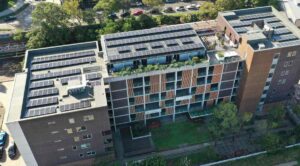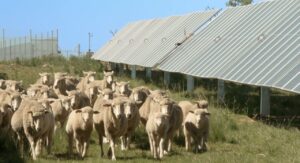Trina Solar says it has started taking orders for a new range of high-efficiency PV modules – Duomax V and Tallmax V – set to arrive in Australia later this year.
The new solar panels promise to deliver more than 500W of power, module efficiency of up to 21 per cent, and to potentially cut the cost of large-scale solar generation by up to 4 per cent.
The higher power rating comes from the incorporation of 210mm diameter silicon cells, Trina says, whose larger size provide a greater area for active light capture, resulting in higher current output.
“The 150 cells in each panel consist of high-efficiency monocrystalline PERC cells and includes a combination of leading solar technologies optimised to boost the panel’s efficiency,” the company said in a statement.
The modules also use “multi-busbar technology” which Trina says keeps internal resistance losses within the module to a minimum, resulting in better low-light performance.
The company also claims that the incorporation of “highly engineered PV technology” has reduced the gap between each cell, therefore enabling higher overall module efficiency that has the potential to boost the balance of system cost savings.
Other features include “advanced three-cut cell technology” to reduce resistance loss and boost resistance to cell-cracks, improve hot spot performance and bolster reliability.
“Customers can order the Duomax V and Tallmax V modules now and deliveries to Australia will start in this year’s third quarter,” said Trina Solar senior country sales manager, Govind Kant.
“We expect to reach 5GW of global manufacturing capacity for the new modules towards end of 2020.”
Trina says the Duomax V bifacial double-glass modules will deliver up to 505W front-side power and, as a bifacial module, can also collect solar energy at the backside and offer further power gain.
Trina says the bifacial module is targeted more at Australia’s utility-scale, commercial and industrial market segments and could pave a way to a more energy yield focused competition in the market.
“The price gap between bifacial and mono-facial is at a level that the energy yield benefits and (balance of system) savings exceeds the cost premium,” Kant said.
“Bifacial modules become a preferred choice for customers, because even if you are only getting a few additional percentage-point gains in efficiency from the rear surface, you are still ahead in terms of dollar per kilowatt-hours you will get from your system.”
Trina cites the example of a solar farm in China’s northeast Heilongjiang province which used the Duomax V modules and achieved a balance of system (BOS) reduction of between 6-8 per cent and levelised cost of electricity (LCOE) decrease of 3-4 per cent, compared to conventional 410W bifacial double-glass modules.
“These results are significant and in Australia the BOS savings could be greater because labour costs in Australia are higher than in China. So any reduction in labour costs in Australia could have a significant positive impact on the project’s financial bottom line,” said Kant.










